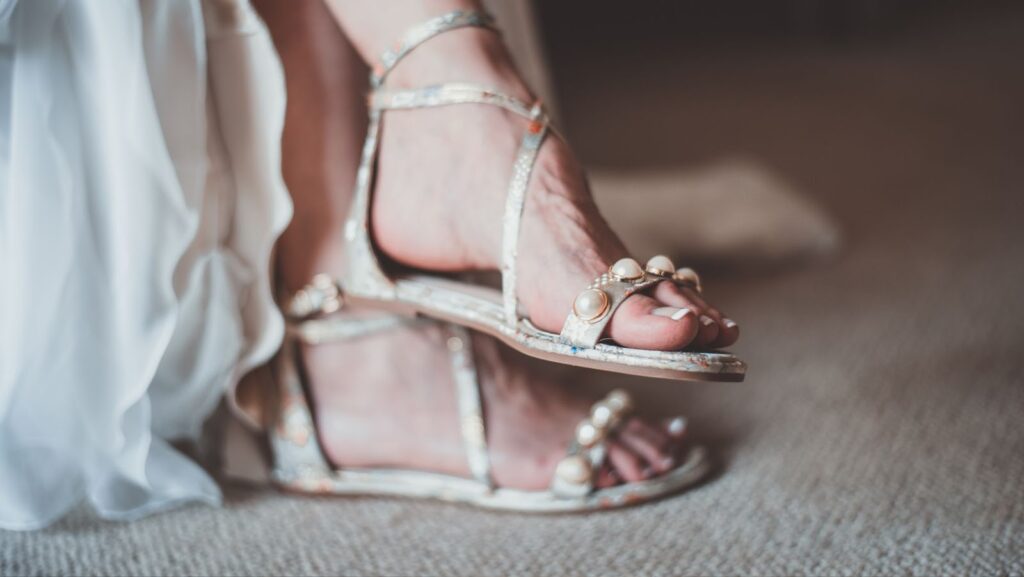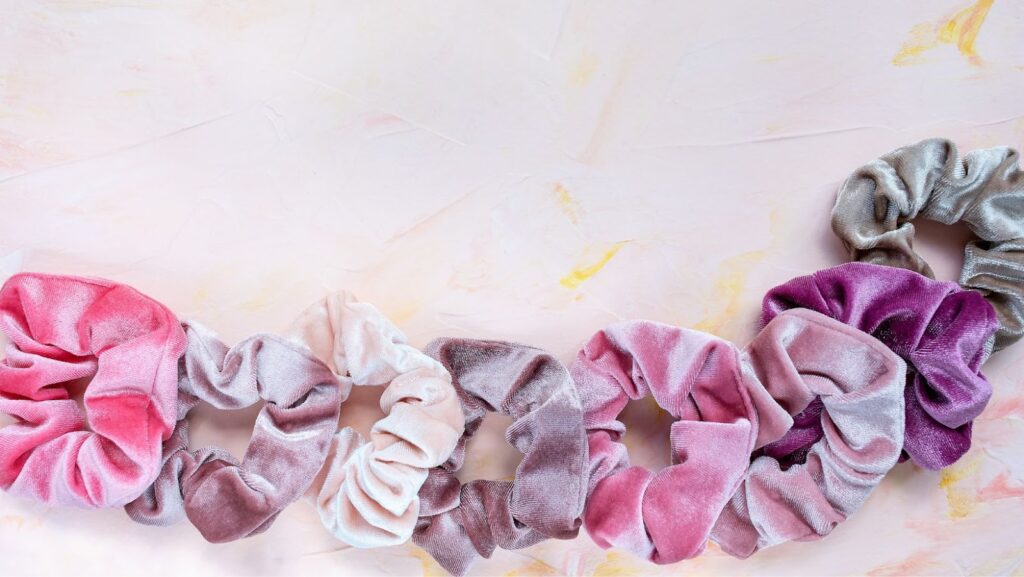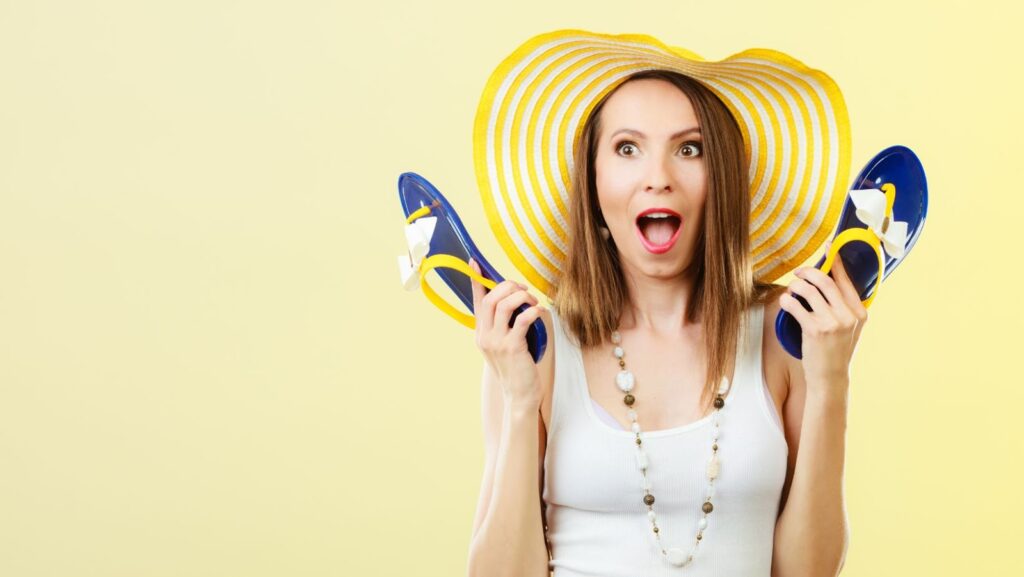Types of footwear
Footwear comes in various designs, materials and styles that differ based on usage, occasion and climate. Here are five types of everyday footwear one should know:
- Sneakers for athletic activities
- Loafers for formal events
- Boots for outdoor trips
- Sandals for summer days
- Flip flops for casual occasions
It’s important to note that these types of footwear can differ in materials such as leather or fabric or even design based on fashion trends and cultural preferences. Understanding the specific use-case and functionality of each type aids in choosing the right pair.
Moreover, the comfort level of footwear depends on its quality and fit, making it important to choose wisely while shopping.
Don’t miss out on adding a stylish yet practical pair of shoes to your collection that fits your needs by exploring different stores and brands.
Wearing sandals is like having a mini-me carrying you around all day, while flip flops are more like throwing caution to the wind and letting your toes live a little.
Sandals
To help you decide whether sandals or flip-flops would be a better choice for you, we are going to discuss sandals in depth. Strap design and materials, typical occasions to wear sandals, and the pros and cons of sandals will all be covered in this section. Get ready to learn about the best features and drawbacks of sandals to help you make an informed footwear decision.
Strap design and materials
The design and materials of the bands on sandals play a critical role in enhancing their overall functionality. Here’s an overview of what one can expect.
| Design | Materials |
| Single strap | Leather |
| Double strap | Suede |
| Ankle strap | Canvas |
Distinctive strap styles such as woven, criss-cross or T-bar offer alternate cuts to the standard variations identified above, further increasing flexibility and support.
Considering the range of designs available for sandal straps, it is important to get the best one that complements your outfit. Do not miss out on harnessing the full potential of these accessories! Why limit yourself to just beach trips and pool parties? Wear sandals to that important job interview and show them you’re one step ahead.
Typical occasions to wear sandals
Sandals are versatile footwear that can be worn on a variety of occasions. They offer comfort, breathability, and style. Here are some scenarios where sandals could be the perfect choice:
- Summer weddings – A pair of dressy sandals can complement formal attire during warm weather nuptials.
- Beach vacations – Sandals are ideal for walking on sand and protect feet from hot surfaces or sharp objects.
- Casual outings – Wearing sandals when running errands, visiting friends, or going shopping is a great way to stay comfortable and stylish.
- Outdoor activities – From hiking to camping to gardening, sandals offer durable protection while still allowing air circulation.
It’s worth noting that not all types of sandals are appropriate for every scenario. Careful consideration should be given to the occasion when selecting the right pair.
In ancient times, gladiator sandals were worn by Roman soldiers in battle. These sandals offered a blend of durability and comfort in combat situations. Today, they’ve evolved into stylish footwear that’s just as comfortable as it is practical.
Sandals: the ultimate footwear choice for showing off your pedicure, but also the perfect way to expose yourself to questionable toe hygiene.
Pros and cons of sandals
Sandals can be a great asset to any wardrobe, but it is important to weigh the advantages and disadvantages before investing in a pair.
- Sandals allow for easy airflow and can be comfortable to wear in hot weather.
- They come in a variety of styles and can suit both casual and dressy occasions.
- Sandals can be convenient to slip on and off, making them ideal for beach trips or running quick errands.
- Some sandals offer additional features such as arch support or cushioning for added comfort.
- However, sandals do not offer much protection for the feet. They leave toes susceptible to injury from objects or uneven surfaces. In addition, they may not provide enough support for activities that require a lot of walking or standing.
- Sandals may also expose the feet to potentially harmful UV rays, causing sunburns or long-term damage.
It’s important to note that some types of sandals are better suited for certain activities than others. For example, flip-flops may not provide the necessary support for hiking or playing sports, while more athletic sandals may offer better comfort and protection.
Additionally, investing in high-quality materials and proper sizing can make all the difference when it comes to overall comfort and durability of sandals. It’s also important to regularly clean and maintain them properly.
Flip flops
To explore the wonders of flip flops, dive into thong design and materials, typical occasions to wear them, and pros and cons of the beloved footwear.
Thong design and materials
This portion of the article explores the architecture and components employed in the creation of appropriate footwear commonly referred to as “flip flops.” The design comprises a thong structure that keeps the foot in place while allowing for maximum ventilation. Materials vary widely, with many flip flops now being crafted with sustainable and eco-friendly materials.
Below is an overview of elements included in the construction of flip flops:
| Component | Purpose |
| Sole | Provides support and cushioning |
| Thong Strap | Holds foot in place |
| Footbed | Conforms to the shape of the wearer’s foot |
A unique feature of some designer brands is a textured sole made from innovative materials like cork or rubber. Certain manufacturers also offer flip flops with a customized monogrammed strap as a fashionable touch.
It is worth noting that some materials used in mass-produced flip flops, like plastics such as polyvinyl chloride (PVC), do not biodegrade rapidly, which tells us how sustainability plays an essential role in this industry. Therefore, it’s fantastic news that more environmentally friendly options are now accessible for buyers who value green fashion choices.
Due to comfort, affordability, and durability qualities, these shoes’ rising popularity has birthed numerous stories on their fascinating history. In Brazil alone, it is estimated that over 200 million pairs were sold per year at one point! From beach trips to emergency grocery runs, flip flops are the perfect choice for when it’s appropriate to show your toes but not your commitment to fashion.
Typical occasions to wear flip flops
When it comes to suitable situations for donning flip flops, there are several to consider:
- Beach and pool outings
- Casual outdoor gatherings or picnics
- Quick trips to the store or running errands
- Lounging around the house or backyard
In addition, flip-flops can be a comfortable choice for those in warmer climates.
It’s worth noting that while flip flops may seem practical and convenient in many situations, they might not be suitable for formal events or long walks.
Don’t miss out on the laid-back comfort of a good pair of flip flops! Just remember to consider the occasion and setting before slipping on your favorite pair. Flip flops: the footwear choice for those who want to feel like they’re on vacation, even when they’re stuck in the office.
Pros and cons of flip flops
Flip-flops are casual, lightweight sandals that are the perfect footwear for hot summer days. Despite their popularity, they come with their fair share of pros and cons.
Pros:
- Flip-flops allow your feet ample space to breathe, preventing sweaty feet and odor.
- They are easy to slip on or off and come in many colors and designs.
- Flip-flops provide relief for some foot conditions like plantar fasciitis as they offer arch support.
- They are affordable and widely available.
Cons:
- Wearing flip-flops for prolonged periods can cause blisters, calluses, and other foot problems.
- Similarly, without proper arch support or cushioning, flip-flop usage can lead to pain in the feet, ankles, calves, knees or hips.
- They lack adequate protection for your toes increasing the risk of injury.
- As they do not offer secure footing on slippery surfaces such as wet pathways or sand dunes, wearing them while walking on uneven terrain is risky.
Sandals vs flip flops
To determine the best footwear option for your needs, you’ll need to compare the benefits of sandals and flip flops. Consider the important factors of comfort, style and fashion, durability and maintenance, as well as price and value for money when making your selection.
Comfort
Sandals and flip flops differ in terms of the level of comfort they offer. Although both provide some level of support, sandals tend to be more comfortable than flip flops due to their better arch support, cushioning, and straps that keep the feet secure. Flip flops may cause foot problems, such as blisters and plantar fasciitis, due to lack of arch support.
Flip flops are best for short-term wear on beaches or around the house while sandals are suitable for all-day wear and outdoor activities. Sandals with contoured footbeds and adjustable straps offer more comfort and versatility than basic flip flops.
To improve comfort, choose sandals with thicker soles and arch support or flip flops made from high-quality materials with cushioned soles. It is also important to choose footwear that fits properly to minimize discomfort and avoid potential injuries. Always try before purchasing and check if they fit well on your feet.
Style and fashion
When it comes to footwear, style and fashion are essential considerations. Choosing between sandals and flip flops can be a daunting task. Here’s what you need to know about the two in terms of style and fashion.
- While both offer unique styles, sandals tend to be more versatile when it comes to dressing up or down.
- Flip flops are excellent for casual occasions but may not work well for formal events.
- Sandals come in a variety of styles, from strappy to gladiator, making them perfect for any outfit.
- Flip flops typically have limited styles that are suitable for shorts and dresses during summer months.
- If you’re looking for an everyday go-to, sandals may be your best bet due to their wider range of styles and patterns.
It’s worth noting that quality is also crucial when it comes to fashion. Cheap flip flops may appear outdated and unflattering, whereas well-made sandals can elevate even the simplest outfits.
Don’t miss out on the chance to have stylish footwear that suits every occasion. Invest in high-quality sandals or flip flops today!
Durability and maintenance
Sandals and flip flops are distinct summer footwear choices. The resilience of these shoes varies, depending on the usage and material. While sandals withstand rough terrains, flip flops have a shorter lifespan and are ideal for leisure activities.
When it comes to maintenance, sandals require more significant cleaning as they tend to harbor dirt in grooves, whereas flip flops need frequent replacement due to wear and tear of the straps. Using silicone-based sprays can enhance water resistance in both types of shoes.
It’s interesting to note that proper storage can significantly extend the lifetime of both sandals and flip flops. Keep them away from direct sunlight and moisture to prevent damage.
Price and value for money
Sandals and flip flops are popular types of footwear, offering comfort during warm weather. When it comes to price and value for money, there are some differences between them that one should consider.
In terms of price, flip flops are generally cheaper than sandals. They are made of simpler materials such as rubber or foam, making them less expensive to produce. Sandals, on the other hand, can be made of leather or other high-quality materials which can make them pricier. However, when it comes to value for money, sandals usually last longer than flip flops due to their sturdier construction and more durable materials.
The table below summarizes the comparison between these two types of footwear with regard to price and value for money.
| Category | Flip Flops | Sandals |
| Price | Affordable | Pricier |
| Material | Rubber/Foam | Leather/other high-quality materials |
| Durability | Less Durable | More Durable |
| Value for Money | Lower | Higher |
It is important to note that while flip flops may be less expensive initially, they may need to be replaced more frequently due to wear and tear compared to sandals. Additionally, some high-end sandals can offer better arch support and comfort than cheaper flip flops, leading to a better overall value for money.
After analyzing the differences between sandals and flip flops, it can be concluded that both have their unique features and benefits. Sandals provide more support and protection while flip flops offer convenience and breathability. However, the choice ultimately depends on personal preference and usage.
Sandals have straps, increased sole thickness, arch support, and are more durable than flip flops. They offer better protection for your feet against debris or rough surfaces. Flip flops provide easy wearability but lack sturdy support. They are ideal for beaches or pool areas where they can be easily worn and removed.
Moreover, while choosing between the two types of footwear, one should consider factors like level of activity, frequency of use, comfort requirements, and weather conditions. Depending on these aspects, the decision can change.
Therefore, to make the most out of your purchase decision always invest in shoes that can last long and satisfy your need of fashion as well as comfort. Additionally, a good pair of socks could also enhance your wearing experience whether it’s sandals or flip-flops.



